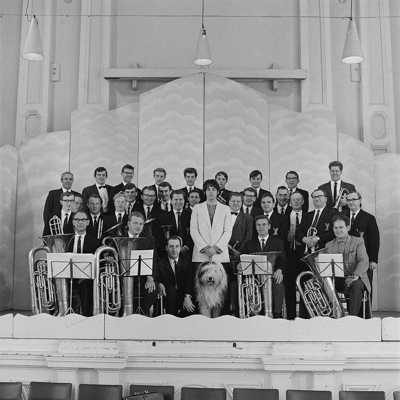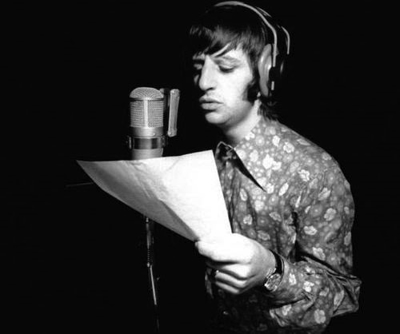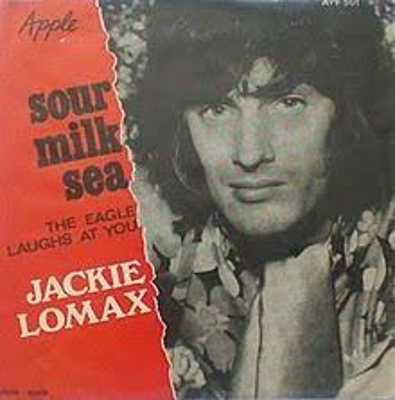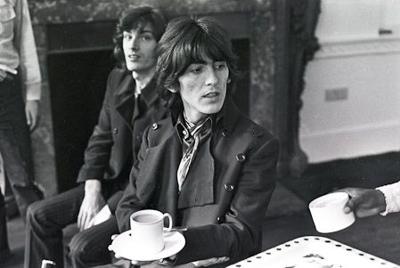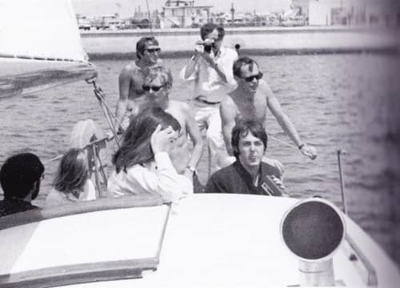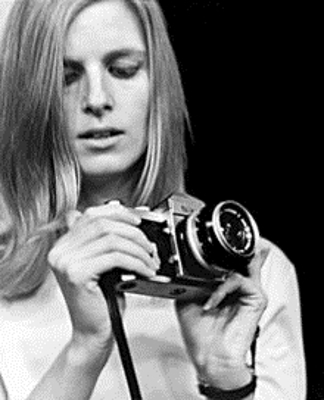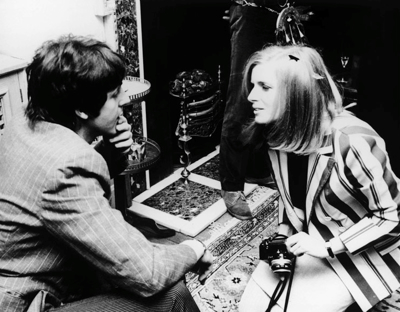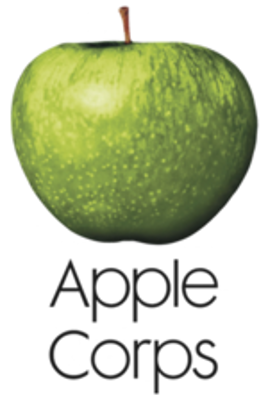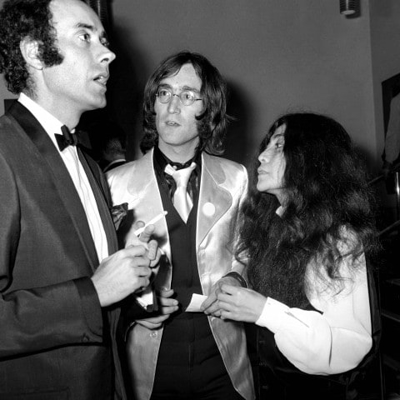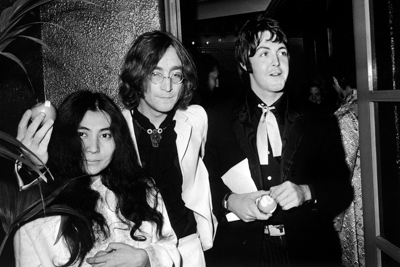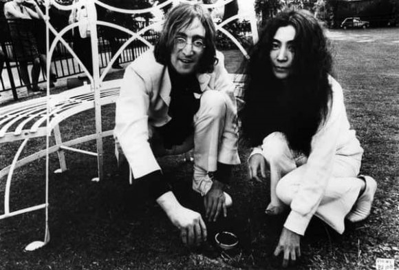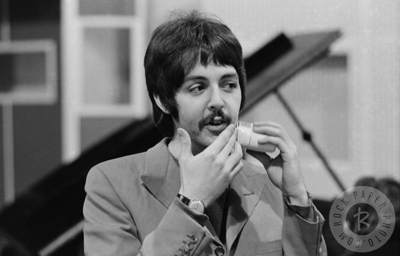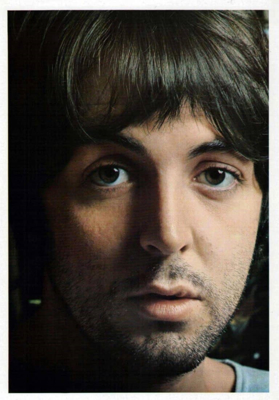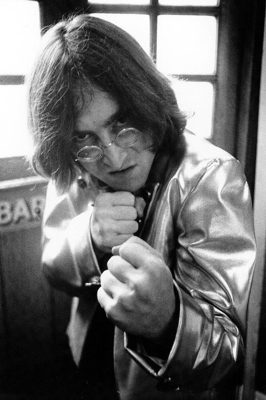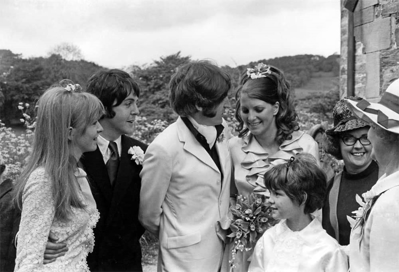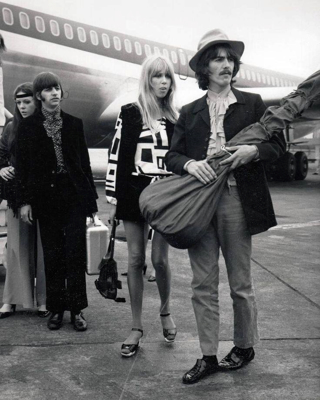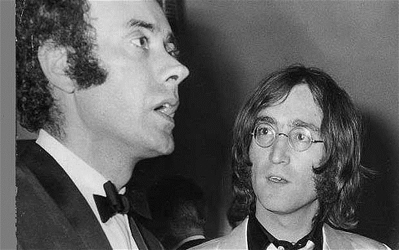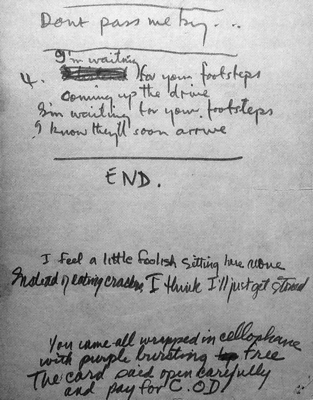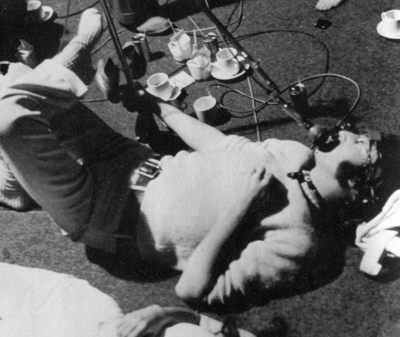BBC interview with John Lennon and Victor Spinetti
While Paul McCartney and Ringo Starr were elsewhere in the studio working on the White Album, John Lennon gave an interview to the BBC about the stage adaptation of his book In His Own Write.
Also present was Victor Spinetti, the play's director and co-writer. The interview was recorded in EMI Studios on London's Abbey Road, and was for the BBC 2 arts show Release. It was first broadcast at 10.05pm on Saturday 22 June.
The interview was conducted by Peter Lewis. It was edited into four parts, and was used between extracts from the stage play filmed in a BBC studio on 21 June.
At the end of the recording session, which finished at 2.45am, Lennon recorded 12 sound effects tapes to be used in In His Own Write. The play opened at the Old Vic Theatre on 18 June.
Peter Lewis: A Beatle at the National theatre, an excerpt from In His Own Write, John Lennon – the writer, and Victor Spinetti – who adapted and directed it. It opened last Tuesday, the critics in general thought it worth trying, even if it didn't altogether work. Among the expectant audience, Lennon readers were delighted, non-readers probably sat there 'astoundaghast'. Sir Lawrence Olivier, director of the National theatre, took a gamble on the play for their triple bill.
It came from Lennon's books, In His Own Write and A Spaniard In The Works, which came out three years ago. They are collections of stories and poems peppered with imaginative and irreverent distortions of the worlds, phrases and names that are part of our everyday reading, listening and viewing, "BBC Panarathma", "Shamrock Womlbs" and "Jack The Nipple" alias Jack The Ripper, there's satire and melancholy and Lennon's eccentric drawings. The play weaves the verse and the prose into a picture of a boy growing up. On one side it's shows his tele fixated family, the human vegetables, on the other the dreams and the fantasies he uses to escape from them. It's like looking at the clichés of post-war Britain in a hall of mirrors provided by Lennon's warped language, this was the achievement of director Victor Spinettti.
John Lennon: When I saw the rehearsal of it, I got quite emotional, as if I'd written it [the adaptation]. I mean, I knew, in my heart of hearts, who was who and what the book was saying, but not enough, I was too involved with it when it was written, and any criticism it had – was either just 'Rubbish' or still only writing about what was on the paper. So it took something like this to happen to make me see what I was about then.
Victor Spinetti: What was interesting about it to me was, the play was brought to me to act in, you see, and when I read it I began to feel, by reading the poems and the stories, the kind of things that happened to me as a kid, and the kind of things I heard, and thank god it corresponded with when John perceived the kind of things that influenced him.
And the most important line in it is really – the influences about us, the things that make us what we are, make you what you are now, or make us what we were, the things that we half heard, you know, as kids.
Peter Lewis: Well an awful lot of the play is about radio and TV.
John Lennon: Well I mean that's all I ever heard, didn't I, I mean you go home...
Victor Spinetti: Comic books, you got the church...
John Lennon: You got yer comic books, yer classic comics, yer Beanos...
Victor Spinetti: Yer school...
John Lennon: Aye, yer school, yer pub and yer TV and yer radio and that was it.
Peter Lewis: Exactly. Funny thing you didn't put in pop music.
John Lennon: No because up 'till then it hadn't hit me. Pop music didn't hit me until I was 16 and this is all before, the things that happened before 16.
Victor Spinetti: But it's not really John's childhood, it's all of ours really, isn't it John?
John Lennon: It is, we're all one Victor, we're all one aren't we? I mean, what's going on?
Peter Lewis: There's another thing about this boy and that is: he won't talk plain English. He invents his own language. Which is what you did when your books started coming out.
John Lennon: Well yeah, that was just a hangover from school. I used to make the lads laugh, with that scene, talking like that, and writing poetry. I used to write them and just give them to friends to laugh at, and that was the end of it. So when they all go down in a book, when it turns into a book or a play etc etc. It's just my style of humour.
Peter Lewis: Instead of saying, for example as I was going to, say "forsample".
Victor Spinetti: "Forsample!" Yes, and "He was astoundaghast!"
John Lennon: Well, some of them 'cause I was never any good at spelling, all me life, I never quite got the idea of spelling. English and writing, fine, but actually spelling the words. And also, I typed a lot of the book, and I can only do it very slowly with a finger, so the stories would be very short 'cause I couldn't be bothered going on. And also I'd spell it as you say it like Latin really, or just try and do it the simplest way to get it over with, 'cause all I'm trying to do is tell a story, and what the words is spelt like is irrelevant really. But if they make you laugh because the word used to be spelt like that, that's great. But the thing is – the story and the sound of the word.
Peter Lewis: A lot of people wrote about your book and said "Oh James Joyce, Edward Lear" and so on, what did you think when they said that?
John Lennon: Well, when they said James Joyce I hadn't, I must have come across him at school but we hadn't done him like I remember doing Shakespeare and I remember doing so and so. I remember doing Chaucer a bit, or somebody like him doing funny words, but I don't remember Joyce. The first thing they say "Oh he's read James Joyce," so I hadn't, so the first thing I do is buy Finnegans Wake and read a chapter and it's great and I dug it and I felt like – here's an old friend, but I couldn't make right through the book, and so I read a chapter of Finnegans Wake and that was the end of it, so now I know what they're talking about. But he just went, he just didn't stop, yeah.
Peter Lewis: What actually though, had you read – that you know was important to you when you were young?
John Lennon: Only kids books, Alice In Wonderland. The poems are all from Jabberwocky, started me into that kick. And drawing I started trying to draw like Ronald Searle when I was about Eight. So there was Jabberwocky and Ronald Searle I was turning into by the time I was Thirteen. I was determined to be Lewis Carol with a hint of Ronald Searle.
Peter Lewis: Were you a Sherlock Holmes reader?
John Lennon: No. I had a holiday after we first made it big as Beatles in Tahiti, and there was nothing on the boat but books. And Tahiti and all those Islands, great, but I still got into reading, so I was writing Spaniard In The Works and I knew, I never got past a story longer than a page, so I read a whole stack, sort of 'The Madman's Sherlock Holmes' where you get all the stories in one and I realised that every story was the same story, so I just wrote one Shamrock Womlbs after Three weeks of Sherlock Holmes in Tahiti. And that was the end of it.
Peter Lewis: There's a very very sad poem at the end of the play about Kakky Hargreaves who is some sort of person who's name changes during the poem who's gone, lost. Who was Kakky Hargreaves?
John Lennon: Nobody was Kakky or Kathy or Tammy, so it was all those people. But the point is that you got it, the sadness that I wrote into it, but after I'd written it, you write something, a song or anything, you get the sadness and then you perform it or you put it on paper and then that's gone and the only way you get the joy back of writing it or the sadness back, is when somebody like Victor or somebody else comes and reads it to you or acts it out, like when I first saw the rehearsal of the play, and they said these words back to me and I got the sadness from Kakky Hargreaves like I'd never heard it before.
Peter Lewis: You wrote that one when you were very young.
John Lennon: Yes. That was sort of pre-Beatle, 18, 19.
Peter Lewis: And have you written lately?
John Lennon: Well I write, I think all the time, so it's the same, I don't put it on paper so much these days, but I mean it goes into songs, a lot of the same energy that went into those poems. I don't know what I actually do with the thoughts but they come out either on film or on paper or on tape. I've just got lots of tape which I suppose if I put onto paper it'd be a book. But it's just a matter of – do I want to make those tapes into paper or make the tapes into records.
Peter Lewis: Does it feel the same to you when you're writing something on paper and when you're writing a song lyric?
John Lennon: Er, it does now. In the old days I used to think song writing was this and you know, "I love you" and "You love me" and my writing was something else, you know. Even if I didn't think of it quite like that. But then I just realised through Dylan and other people, Bob Dylan – not Thomas, that it is the same thing. That's what I didn't realise, being so naive, you know, that you don't write pop songs and then you do that and then you do that. Everything you do is the same thing, so do it the same way.
But sometimes I'll write lyrics to a song first and then I'll get the same feeling as Kakky Hargreaves or a poem and then write the music to it after. So then it's a poem sung, sometimes the tune comes and then you just put suitable words to fit the tune, if the tune's doo der loo der loo der la and then you have shagga boo choo cha – you know, you have sound words then, just the sound of it, 'cause it is all sound, everything's vibrations I believe, you know, everything is sound really, or vision. And just the difference between sound and vision I'm not quite sure about. But it's all just 'vurururururururururu...'
Peter Lewis: You live in a 'vurururururururu...''
John Lennon: Yes, I'm just aware that is going on all the time, like that camera is purring and those people are humming over there and you're breathing and inhaling and he's humming and I'm talking on a mmm mmm, so all the time this – is – going – on – like – this – all – the – time. And so I'm aware of that, really.
Peter Lewis: The boy [in the play] hates a lot of things and in a way, you could say you were attacking these things, like organized religion, and the way people teach you in school.
John Lennon: I feel the same now, really, about organized religion, education and all those things that everybody is still laughing at. But I mean, I expressed it that way then. I don't know how I'd express it now, you know. It'd be slightly different really.
Victor Spinetti: But there's a tremendous amount of compassion in his writing, which I love. It really is saying 'Come on, do what you want to do'.
John Lennon: Because, I mean, I've always sort of suspected that there was a God, even when I thought I was an atheist... (Whispers) Just in case..... But I believe it, so I am full of compassion really, you can still, sort of, just dislike things. I just hate things less strenuously than I did. I haven't got as big of a chip about it, because maybe I've escaped out of it a bit. I think our society is run by insane people for insane objectives. And I think that's what I sussed when I was 16 and 12, way down the line. But I expressed it differently all through my life.
It's the same thing I'm expressing all the time. But now I can put it into that sentence that I think we're being run by maniacs for maniacal ends, you know. If anybody can put on paper what our government, and the American government, and the Russian, Chinese... what they are actually trying to do, and what they think they're doing, I'd be very pleased to know what they think they're doing. I think they're all insane. But I am liable to be put away as insane for expressing that, you know. That's what is insane about it. I mean, don't you agree?
Peter Lewis: I do, actually.
John Lennon: It's not just a bit strange. It's just insane, and nobody knows, all these people in the street and half the people watching this are going to be saying, 'What's he saying! What's he saying!' You know. You are being run by people who are insane, and you don't know.
Victor Spinetti: The real world was so insane, the fantasy world becomes something much better. We are living in insane times, aren't we. We really are.
Peter Lewis: Yeah. And the thing that you feel, all the way through, is that, there's this boy trying to get out.
John Lennon: Well, I did, you see. I got out. But that's just a sort of picture of somebody who is still in it. I mean, you get out in your mind.
Peter Lewis: Yeah, all the time he is dreaming his way out.
John Lennon: But I mean, you do, until you actually physically get out of it.
Peter Lewis: Dream your way out into being Sherlock Holmes or...
John Lennon: Whatever.
Victor Spinetti: Whatever. And when the boy leaves at the end, I don't see him going into reality, his reality is his closely knit family locked up in television, he's going into fantasy which I think is a real world.
Peter Lewis: At the end of the play, there's this big family group, and there's a great big family row.
John Lennon: Is there?
Victor Spinetti: Yes, 'Brummer Striving'.
John Lennon: Oh, Brummer Striving!
Peter Lewis: It's all about Brummer Striving, do tell us about Brummer Striving.
John Lennon: Brummer Striving is Brummer Striving, all those jobs that people have that they don't want, and there's probably about 90% Brummer Strivers watching in at the moment. But you don't have to be a Brummer Striver, you see. It depends how involved in Brummer Striving you are, but Brummer Striving... Paul explained it at the beginning of the book, is, errr, it doesn't... What does he say he was saying? – 'What is Brummer Striving?' It isn't anything.
Victor Spinetti: It's grafting, it's doing a job. It is any kind of job you have to graft at, like going to a steelworks, or to a coal man to follow your father.
John Lennon: The universal sorrow just hits you once about a week, now – Bang – And they you say, 'Oh, oh well', and then you're back to 'Well, get on with it', you know, 'Get on with it'.
Peter Lewis: And laugh.
John Lennon: Well, I mean there are laughs to compensate, 'cause if there weren't it'd be very melancholy.


